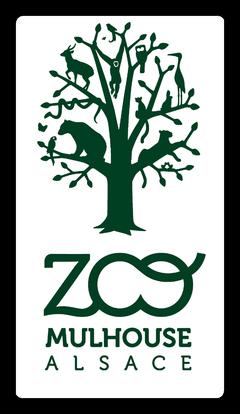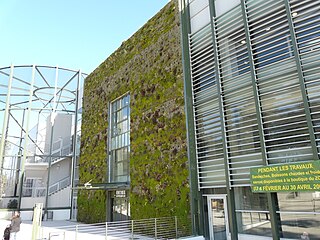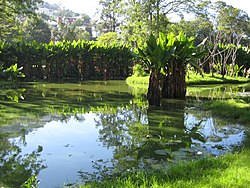
The French National Museum of Natural History, known in French as the Muséum national d'histoire naturelle, is the national natural history museum of France and a grand établissement of higher education part of Sorbonne Universities. The main museum, with four galleries, is located in Paris, France, within the Jardin des Plantes on the left bank of the River Seine. It was formally founded in 1793 during the French Revolution, but was begun even earlier in 1635 as the royal garden of medicinal plants. The museum now has 14 sites throughout France.

The Madagascar Biodiversity Center or Bibikely Biodiversity Center is Madagascar's first and only biodiversity research center, and is a joint project of the Bibikely Biodiversity Institute, and the California Academy of Sciences, in cooperation with the Malagasy government.

The Cantonal Botanical Museum and Gardens in the Canton of Vaud, Switzerland, comprises the museum and botanical garden in Lausanne, as well as the botanical garden, La Thomasia, in the Alps near the town of Bex. Administered under the Service of cultural affairs of Vaud, the museum and gardens engage in the study and protection of local flora, as well as in promoting public awareness in biodiversity and nature education in general.

The Madagascar Fauna and Flora Group(MFG) is an international consortium of zoos and other conservation agencies which pool resources to help conserve animal species in Madagascar, through captive breeding programs, field research programs, training programs for rangers and wardens, and acquisition and protection of native habitat in Madagascar. It is a non-governmental organization working in conjunction with the Ministry of Water, Forests, and the Environment, Government of Madagascar. It is the organization behind the Save the Lemur campaign and is headquartered at the Saint Louis Zoo.
Parc Ivoloina (eev’-uh-lah-ween) is a recreational and educational zoological park home to lemurs, reptiles, amphibians, and other native Malagasy species near the city of Toamasina in eastern Madagascar. On their own or with a guide, visitors can explore the wildlife exhibits, orchards, an education center, model agricultural station, historic ruins, and nine kilometers of hiking trails. A dugout canoe tour is also available. A sampling can be accomplished as a day trip or visitors can arrange multiple days staying overnight.

The Saigon Zoo and Botanical Gardens is Vietnam's largest zoo and botanical garden. The Saigon Zoo and Botanical Gardens was commissioned by Admiral Pierre-Paul de La Grandière in 1864, and was opened to the public in 1869, making it one of the world's oldest continuously operating zoos.

The Parc de la Tête d'or is a large urban park in Lyon, France, with an area of approximately 117 hectares. Located in the northern part of the 6th arrondissement, it features the Jardin botanique de Lyon, as well as a lake on which boating takes place during the summer months. Due to the relatively small number of other parks in Lyon, it receives a huge number of visitors over summer; it is a frequent destination for joggers and cyclists.

The Mulhouse Zoological and Botanical Park is a French zoological park located in the Grand Est region in the departement of Haut-Rhin, in the southeast of the city of Mulhouse, district of Rebberg. Created in 1868 by philanthropists industrialists, led by Charles Thierry-Mieg son, he was successively the property of the Cercle mulhousien, of the Industrial Society of Mulhouse, and then of the City from 1893. It is now managed by the agglomeration community of Mulhouse region, Mulhouse Alsace Agglomération. Its director is, since 2010, the veterinary Brice Lefaux.

The Lautaret Alpine Garden is an alpine botanical garden located at 2100 metres altitude in the Col du Lautaret of the Dauphiné Alps, near Villar-d'Arêne, Hautes-Alpes, Provence-Alpes-Côte d'Azur, France. It is part of the List of Remarkable Gardens of France certified by the Ministry of Culture (France).

The Montpellier Zoological Park is a French zoological park located in the region Occitanie, in the north of the city of Montpellier.

The Zoo and Botanical Garden of Branféré is a 35-hectare (86-acre) zoo and botanical garden located in Le Guerno, Morbihan, Brittany, France.

Pierre Louis Boiteau was a French botanist, born on 3 December 1911 in Cognac and dying on 1 September 1980 in Orsay, Essonne. One of his daughters, Lucile Boiteau-Allorge, is also a botanist.

The flora of Madagascar consists of more than 12,000 species of plants, as well as a poorly known number of fungi and algae. Around 83% of Madagascar's vascular plants are found only on the island. These endemics include five plant families, 85% of the over 900 orchid species, around 200 species of palms, and such emblematic species as the traveller's tree, six species of baobab and the Madagascar periwinkle. The high degree of endemism is due to Madagascar's long isolation following its separation from the African and Indian landmasses in the Mesozoic, 150–160 and 84–91 million years ago, respectively. However, few plant lineages remain from the ancient Gondwanan flora; most extant plant groups immigrated via across-ocean dispersal well after continental break-up.
Secamonopsis microphylla is a plant species endemic to southern Madagascar. It is a trailing or erect herb up to 1.5 m tall. Leaves are narrowly oblong, up to 10 mm long. Flowers in groups of 1–3, yellow, tubular, up to 1.2 mm long.

Lemurs' Park is a small botanical garden and lemur reserve covering 5 ha, and is located 22 km (14 mi) southwest of Antananarivo, Madagascar. It was founded around 2000 by Laurent Amouric and Maxime Allorge. Most of its nine lemur species are free-ranging within the park, which also contains more than 70 of Madagascar's endemic plant species. The park is open to the public, offering guided tours as well as standard amenities, a gift shop, and a restaurant. Visitors can arrange transportation between downtown Antananarivo and Lemurs' Park on a private park shuttle.

The Conservatory and Botanical Garden of the city of Geneva is a museum and an institution of the City of Geneva.

The Hann Forest and Zoological Park is a nature reserve located in Dakar, the capital of the African country of Senegal, in the Hann Bel-Air commune.

The Eala Botanical Garden is a botanical garden in Mbandaka in the Democratic Republic of the Congo.

Lucile Allorge is a Madagascar-born French botanist.


















